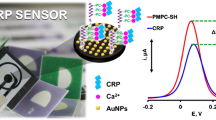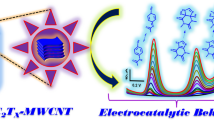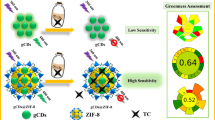Abstract
Nanocomposite materials are potentially revolutionizing many technologies, including sensors. In this paper, we described the application of “PANI/MWCNTs/Starch” modified carbon paste electrode (PCS-CPE) as a simple and highly sensitive cholesterol sensor. This novel nano-composite material has integrated nano-morphology, where polyaniline could interact effectively with the additives; pi-pi stacking “MWCNTs,” and covalently bonded with starch. Specific binding sites (sugar chains), better electro-catalytic properties and fast electron transfer facilitated the oxidation of cholesterol. Fourier transform infrared spectra confirmed the interaction of cholesterol with the composite material. The sensing response of PCS was measured by cyclic voltammetry and chronoamperometry (0.1 M PBS-5 used as supporting electrolyte). As the amount of cholesterol increased in the test solution, cyclic voltammograms showed a rise of peak current (cathodic and anodic). Under the normal experimental conditions, the developed sensor exhibited wide linear dynamic range (0.032 to 5 mM) (upper limit is due to lack of solubility of cholesterol), high sensitivity (800 μAmM−1 cm−2), low detection limit (0.01 mM) and shorter response time (within 4–6 s). Analytical specificity, selectivity, and sensitivity during cholesterol estimation were compared with the response of some other analytes (ascorbic acid, glucose, l-dopa, urea and lactic acid). This novel sensor was successfully applied to estimate cholesterol in cow milk (used as a model real sample). The sensing platform is highly sensitive and shows a linear response towards cholesterol without using any additional redox mediator or enzyme, thus this material is extremely promising for the realization of a low-cost integrated cholesterol sensor device.

Cyclic voltammetric response of cholesterol of composite modified carbon paste capillary electrode








Similar content being viewed by others
References
Tiwari I, Singh KP, Singh M. An insight review on the application of polymer-carbon nanotubes based composite material in sensor technology. Russ J Gen Chem. 2009;79(12):2685–94.
Tiwari I, Singh KP. Composite materials based on ormosil for the construction of electrochemical sensors and biosensors. Russ J Gen Chem. 2012;82(1):157–67.
Miao P, Tang Y, Wang L. DNA modified Fe3O4@Au magnetic nanoparticles as selective probes for simultaneous detection of heavy metal ions. ACS Appl Mater Interfaces. 2017;9(4):3940–7.
Dou R, Du Z, Bao T, Dong X, Zheng X, Yu M, et al. The polyvinylpyrrolidone functionalized rGO/Bi2S3nanocomposite as a near-infrared light-responsive nanovehicle for chemo-photothermal therapy of cancer. Nanoscale. 2016;8:11531–42.
Saxena U, Das AB. Nanomaterials towards fabrication of cholesterol biosensors: key roles and design approaches. Biosens Bioelectron. 2016;75:196–205.
Pollegioni L, Piubelli L, Molla G. Cholesterol oxidase: biotechnological applications. FEBS J. 2009;276(23):6857–70.
Herrera-López E. Lipase and phospholipase biosensors: a review. J Methods Mol Biol. 2012;861:525–43.
Ahmadraji T, Killard AJ. Measurement of total cholesterol using an enzyme sensor based on a printed hydrogen peroxide electrocatalyst. Anal Methods. 2016;8:2743–8.
Pundir CS, Narang J, Chauhan N, Sharma P, Sharma R. An amperometric cholesterol biosensor based on epoxy resin membrane bound cholesterol oxidase. Indian J Med Res. 2012;136(4):633–40.
Aggarwal V, Malik J, Prashant A, Jaiwal PK, Pundir CS. Amperometric determination of serum total cholesterol with nanoparticles of cholesterol esterase and cholesterol oxidase. Anal Biochem. 2016;500:6–11.
Nantaphol S, Chailapakul O, Siangproh W. A novel paper-based device coupled with a silver nanoparticle-modified boron-doped diamond electrode for cholesterol detection. Anal Chim Acta. 2015;891:136–43.
Ahmad R, Tripathy N, Park JH, Hahn YB. A comprehensive biosensor integrated with a ZnO nanorod FET array for selective detection of glucose, cholesterol and urea. Chem Commun. 2015;51(60):11968–71.
Ahmad R, Tripathy N, Hahn YB. High-performance cholesterol sensor based on the solution-gated field effect transistor fabricated with ZnO nanorods. Biosens Bioelectron. 2013;45:281–6.
Zhang M, Yuan R, Chai Y, Wang C, Wu X. Cerium oxide-graphene as the matrix for cholesterol sensor. Anal Biochem. 2013;436(2):69–74.
Lakshmi GB, Sharma A, Solanki PR, Avasthi DK. Mesoporous polyaniline nanofiber decorated graphene micro-flowers for enzyme-less cholesterol biosensors. Nanotechnology. 2016;27(34):345101–7.
Singh B, Bharadwaj N, Jain VK, Bhatia V. A novel nanographite based non-enzymatic cholesterol sensor. In: Jain V., Verma A. (eds) Physics of Semiconductor Devices. Environmental Science and Engineering. Springer, Cham. 2014; 531–34. https://doi.org/10.1007/978-3-319-03002-9_133.
Agnihotri N, Chowdhury AD, De A. Non-enzymatic electrochemical detection of cholesterol using β-cyclodextrin functionalized graphene. Biosens Bioelectron. 2014;63:212–7.
Rengaraj AK, Haldorai Y, Kwak CH, Ahn S, Jeon KJ, Park SH, et al. Electrodeposition of flower-like nickel oxide on CVD-grown graphene to develop an electrochemical non-enzymatic biosensor. J Mater Chem B. 2015;3:6301–9.
Yang J, Lee H, Cho M, Nam J, Lee Y. Nonenzymatic cholesterol sensor based on spontaneous deposition of platinum nanoparticles on layer-by-layer assembled CNT thin film. Sensor Actuat B Chem. 2012;171-172:374–9.
Yoon HS, Lee SJ; Park JY, Paik SJ, Allen MG. A non-enzymatic micro-needle patch sensor for free cholesterol continuous monitoring sensors. IEEE. 2014.https://doi.org/10.1109/ICSENS.2014.6985005.
Li Y, Bai H, Liu Q, Bao J, Han M, Dai Z. A nonenzymatic cholesterol sensor constructed by using porous tubular silver nanoparticles. Biosens Bioelectron. 2010;25(10):2356–60.
Alexander S, Baraneedharan P, Balasubrahmanyan S, Ramaprabhu S. Modified graphene based molecular imprinted polymer for electrochemical non-enzymatic cholesterol biosensor. Eur Polym J. 2017;86:106–16.
Tong Y, Li H, Guan H, Zhao J, Majeed S, Anjum S, et al. Electrochemical cholesterol sensor based on carbon nanotube@molecularly imprinted polymer modified ceramic carbon electrode. Biosens Bioelectron. 2013;47:553–8.
Ji J, Zhou Z, Zhao X, Sun J, Sun X. Electrochemical sensor based on molecularly imprinted film at au nanoparticles-carbon nanotubes modified electrode for determination of cholesterol. Biosens Bioelectron. 2015;66:590–5.
Trojanowicz M. Application of conducting polymers in chemical analysis. Microchim Acta. 2003;143(2):75–91.
Das TK, Prusty S. Review on conducting polymers and their applications. Polym Plast Technol. 2012;51(14):1487–500.
Tiwari I, Singh KP. In situ synthesis of polymer nanocomposites from PANI/PAA/MWCNTs: analysis and characterization. Int J Polym Anal Charact. 2012;17:371–80.
Gautam V, Srivastava A, Singh KP, Yadav VL. Preparation and characterization of polyaniline, multiwall carbon nanotubes and starch bionanocomposite material for potential bioanalytical applications. Polym Compos. 2017;38(3):496–506.
Gautam V, Srivastava A, Singh KP, Yadav VL. Vibrational and gravimetric analysis of polyaniline/polysaccharide composite materials. Polym Sci Ser A. 2016;58:206–19.
Tiwari I, Singh KP, Singh M, Banks CE. Polyaniline/polyacrylic acid/multi-walled carbon nanotube modified electrodes for sensing ascorbic acid. Anal Methods. 2012;4:118–24.
Oh HI, Shin TS, E.J. Chang EJ. Determination of cholesterol in milk and dairy products by high performance liquid chromatography. Asian Australas J Anim Sci. 2001;14(10):1465–9.
Chen ZY, Kwan KY, Tong KK, Ratnayake WMN, Li HQ, Leung SSF. Breast milk fatty acid composition: a comparative study between Hong Kong and Chongqing Chinese. Lipids. 1997;32(10):1061–7.
Demmelmair H, Baumheuer M, Koletzko B, Dokoupil K, Kratl G. Investigation of long chain polysaturated fatty acid metabolism in lactating woman by means of stable isotope techniques. Part of advances in experimental medicine and biology book series (AEMB, Vol 501, p. 169–177), Springer. https://doi.org/10.1007/978-1-4615-1371-1_2.
Precht D. Cholesterol content in European bovine milk fats. Nahrung. 2001;45(1):2–8.
Altenhofer C, Holzmüller W, Wolfertstetter F, Ribeiro DW, Kulozik U, Pfaffl MW, et al. Temporal variation of milk fat globule diameter, fat and cholesterol content and milk epithelial cell gene expression in dairy cows. Int J Dairy Technol. 2015;68(4):519–26.
Acknowledgements
The authors (Vinita Gautam) acknowledge the MHRD for senior research fellowship; Head, department of chemical engineering and technology for research facilities; Coordinator, School of Biochemical Engineering for providing electrochemical facilities; members of MITWS for intellectual support to complete this manuscript.
We are thankful to Priyanka (research scholar, department of ceramic engineering, IIT - BHU), and other friends for giving valuable suggestions during the editing phase of this manuscript.
Author information
Authors and Affiliations
Contributions
All the authors contributed equally to prepare this manuscript.
Corresponding author
Ethics declarations
The present research work does not involve any human participants and/or animals.
We have informed all the authors and other related authorities in regard to this communication.
Conflict of interest
The authors declare no conflict of interest.
Electronic supplementary material
ESM 1
(PDF 9563 kb)
Rights and permissions
About this article
Cite this article
Gautam, V., Singh, K.P. & Yadav, V.L. Polyaniline/MWCNTs/starch modified carbon paste electrode for non-enzymatic detection of cholesterol: application to real sample (cow milk). Anal Bioanal Chem 410, 2173–2181 (2018). https://doi.org/10.1007/s00216-018-0880-6
Received:
Revised:
Accepted:
Published:
Issue Date:
DOI: https://doi.org/10.1007/s00216-018-0880-6




